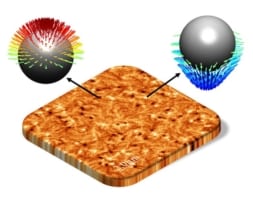
Physicists at the University of Colorado Boulder have become the first to observe a new phase of matter in liquid crystals. The “ferroelectric nematic” phase, which was first predicted to exist over 100 years ago, could find applications in many different areas, from new types of display screens to reimagined computer memory, says study leader Noel Clark.
“There are 40 000 research papers on nematics, and in almost any one of them you see interesting new possibilities if the nematic had been ferroelectric,” Clark explains. “Our discovery of one such liquid crystal could open up a wealth of technological innovations.”
Threads with order
Nematic liquid crystals display an odd mix of fluid- and solid-like behaviours, and get their name from the Greek word nema, meaning “thread” – a reference to the characteristic thread-like topological defects they contain. These defects are known as disclination lines, and they can be made of elongated molecules or colloidal particles. These molecules are polar, with one end carrying a positive charge and the other a negative one. In a traditional nematic crystal, half of these molecules will on average point in one direction (right, for example) and the other half in the other (say, left).
A ferroelectric nematic liquid crystal is more organized. Within specific patches or “domains”, all of its molecules point in the same direction. This phenomenon is known as polar ordering, and its appearance in nematic liquid crystals was first hypothesized in the 1910s by the Nobel laureates Peter Debye and Max Born. They predicted that if a liquid crystal were designed correctly, its molecules could spontaneously fall into a polar ordered state.
Shortly afterwards, researchers discovered solid crystals in which molecules did indeed point in uniform directions. The direction of these molecules could be reversed, from right to left or vice versa, when an electric field was applied – a property that inspired the name “ferroelectrics” because of similarities to ferromagnets. Despite much searching, however, a liquid crystal phase that behaves in the same way proved elusive – until now.
Strong polar order
Clark and colleagues observed their ferroelectric nematic liquid crystal phase in an organic molecule known as RM743. This molecule was created by another team a few years ago, in a study that showed that it exhibits a conventional nematic crystal phase at high temperatures. When cooled, however, another unusual phase appeared, and it is this phase that the Colorado researchers analysed using polarized light microscopy.
During their measurements, the researchers observed that when they applied a weak electric field to the material, a striking palette of colours developed towards the edges of the cell containing the liquid crystal. Overall, the team found that in this phase, RM734 is 100 to 1000 times more responsive to electric fields than traditional nematic liquid crystals. According to their calculations, this means that the molecules making up the crystals show strong polar order.
The researchers also discovered that distinct domains form spontaneously in the liquid crystal when it is cooled from higher temperatures. This suggests that there are patches within the materials in which the molecules seem to be aligned – a hallmark of a ferroelectric nematic fluid, Clark says. Surprisingly, the alignment was more uniform than expected for a fluid, in which entropy reigns and there should be a lot of disorder.

Thread-like defects in 3D active crystals get a closer look
When the team analysed how well aligned the molecules were inside a single domain, they were “stunned” by the result. The molecules were nearly all pointing in the same direction, with only a few pointing in a completely different direction.
AI to screen potential new molecules
The researchers, who report their work in PNAS, say they are now busy trying to understand the mechanisms behind this alignment. “Our work suggests that there are other ferroelectric fluids hiding in plain sight,” says Clark. “It is important for us now to broaden the pool of molecules beyond the few (roughly five) now known to show this phase,” he tells Physics World.
The materials unearthed so far show the ferroelectric phase at elevated temperatures, so one goal of future research is to find room temperature materials, he adds. “We’re moving towards using artificial intelligence (AI) to screen potential new molecules without having to actually synthesise them. Indeed, 200 000 new molecular designs were made in the development and evolution of conventional nematic crystals LCDs, so we could avoid going through this.”



